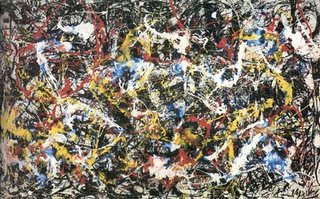Doing 'a Quick Jackson Pollock'

"He was full of sh*t like everyone else." -- Art critic Clement Greenberg
Jackson Pollock, the catalyzing force of Abstract Expressionism known as "Jack the Dripper," was born on this day in 1912 in Cody, Wyoming.
A student of Thomas Hart Benton, Pollock's early work consisted mostly of nervous figurative paintings, but by 1947, he had thrown away both pencil and brush, constructing spontaneously/intuitively designed networks of lines across drips and splatters on large canvases laid out on his studio floor. His unique approach grew out of his rebellion from his formal training -- by dripping over his canvases, he could avoid thinking about the position of his brush and his wrist and his elbow in an academic way, and could liberate the creative process.
Although he became a poster-boy for the apparent randomness of modern art (in part, through the enthusiastic support of critics like the afore-quoted Greenberg), his canvases were anything but random; at close study they reveal a consistency of plan and personality, with numerous shades of feeling and tantalizing ambiguities. In Pollock's larger canvases, painting was no longer a scene to be viewed on a wall, but a fluttering environment, enveloping the viewer.
His contemporaries certainly found inspiration in his work -- deKooning wrote "[E]very so often a painter has to destroy painting. Cezanne did it, Picasso did it with Cubism. Then Pollock did it. He busted our idea of a picture all to hell. Then there could be new paintings again."
Pollock died in a car crash while driving drunk, August 11, 1956 in East Hampton, New York, leaving behind his wife, painter Lee Krasner.
Pollock's methodology is probably more famous than all of his individual paintings combined, causing his name to enter the lexicon (sort of), as in the instruction of British TV chef Nigella Lawson to do a "quick Jackson Pollock with the olive oil." Such pop culture sprinklings -- along with increasing sales prices for his works at auction in recent years, and the 2003 revelation that a retired long-haul truck driver who purchased a funny looking canvas for $5 at a roadside thrift store several years ago had suddenly discovered that she might be the owner of a $20 million Pollock original -- have helped to catapult Pollock to a posthumous comeback. Inevitably, Hollywood got into the act as well -- his alcoholism, self-doubt and mercuriality were chronicled in Ed Harris' film Pollock (2000), and were referenced in a cloning fantasy, Pollock Squared (2003).
Labels: Painting and Sculpture





0 Comments:
Post a Comment
Subscribe to Post Comments [Atom]
<< Home